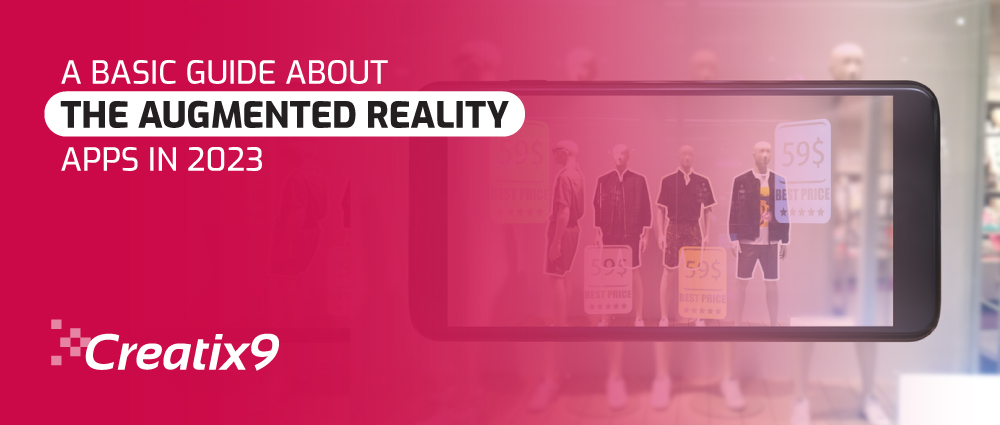
While augmented reality apps can appear fantastical to some consumers, companies like Target and IKEA see them as a competitive advantage and a game-changer. It has revolutionized how people interact with digital media across the e-commerce, entertainment, and education industries. As a result of its sudden rise in the international business scene, many young companies and digital entrepreneurs are keen to develop AR apps.
If you’re interested in the same thing, you’ve come to the right location. In this blog, Creatix9 US offers the best IoT app development and robotic process automation services and has everything you need to know. We will discuss Augmented Reality Apps in 2023, their future predictions, benefits, and general features used in augmented Reality (AR) apps.
The Future of Augmented Reality Apps: Predictions for the AR Market?
Here are a few estimations to help convince today’s business owners that augmented reality is the way to go.
There were 1.1 billion mobile augmented reality users worldwide in 2022, with predictions of 1.7 billion by 2024.
The augmented reality market is projected to expand rapidly, with key sub-segments including augmented reality apps, software, hardware, and other industrial devices.
As of 2021, the global augmented reality market was valued at over $9.53 billion. Analysts anticipate a dramatic turnaround, with the industry reach to about USD 13 billion in 2023 and USD 26 billion in 2025.
As of 2022, there are 363 million active users on Snapchat every day. The app is famous for incorporating augmented reality into its basic technical design.
The exact number of people will have downloaded the augmented reality software Pokémon Go by 2023.
Where Do People Who Use Augmented Reality Technologies Live?
The United Arab Emirates, the United States, and Saudi Arabia are the three most important markets for augmented reality apps and related technology companies. It is projected that by 2025, buyers in Saudi Arabia (45%), the United Arab Emirates (42%), and the United States (28%). Will have used AR-enabled applications while making purchases made online.
One-third of U.S. internet buyers will have used augmented reality tools like virtual try-ons and oculus by 2025. Canada, the United Kingdom, and Australia are just a few other countries.
Main Advantages Of Creating Augmented Reality Apps For Businesses

While the statistics about the augmented reality show the essential guide on the customers about the usage of augmented reality, here are some practical advantages to using augmented reality for all kinds of business: SME or Startup or well-established working as B2C or B2B.
- Competitive Advantage
- Virtual Try-on
- Unique Customer Experience
- Improved Marketing and Sales
Using Augmented Reality in your business strategy, advertising efforts, or direct products or services shows that you can keep up with the market’s demands and are willing to try new things. You can present your business as one that makes science fiction a reality for your ideal customers by being an early adopter with a forward-thinking mindset. Taking an edge over the competition in the business world is more significant than ever. It is no longer a slogan but still a suitable method for most Forbes startups to introduce themselves.
Businesses and entrepreneurs can take the AIDA model from theoretical to practical using augmented reality. Here’s how augmented Reality (AR) can help you attract customers while also reflecting your company’s adaptability:
Augmented reality raises awareness of a company’s name. Some companies, like Sephora and Warby Parker, have already used this advertising method.
The ability to virtually experience a product before making a purchase increases interest in and enthusiasm for that product among the target audience.
At long last, Augmented Reality (AR) can motivate your audience to take action, see, and buy in the purchase lifecycle.
Enhancing both internal and exterior visual communications, AR is beneficial for advertising and the development of fresh client experiences. You can use augmented reality to teach customers and internal audiences to maximize user engagement.
Industrial Applications Of Augmented Reality
Here are some excellent augmented reality examples being successful where these industries can install in their businesses:
- Healthcare: enhance the experience of a patient during counselling and therapies section.
- Tourism: to interpret and translate signboards in remote places
- Real Estate: Purchase of augmented home and new experience
- Education: execute medical training via growth program via AR-enabled applications.
- Gaming: communication between the virtual and real world using simulations
- E-commerce and retail: better experience when shopping with virtual try-on
- Automotive: completely digital display area for automobile show and sales representation
- Design modelling and architecture: automated and real-time changes to engineering designs and floor plans.
General Features Worth Seeking Out In An Augmented Reality SDK

Since augmented reality apps are becoming increasingly popular, programmers who want to make their own must find an SDK that provides the required functionality. There are a lot of aspects that developers need to think about while deciding on an augmented reality software development kit. No single software development kit (SDK) may exist for augmented reality apps that meet the needs of every company.
The type of project you’re working on matters less than that you’re looking for a set of standard capabilities in an AR SDK. To name a few examples:
1. Methods for Tracking 3D Objects
With 3D object tracking, programmers can make apps where material things can serve as AR markers. With this component, developers would greatly expand the experiences they could provide to end users in augmented reality.
Including 3D objects, tracking has numerous benefits for app creators. If a toy business were to offer an action figure alongside an AR app, the product would come to life.
In the future, it will be possible for a filmmaking app to follow a person or object’s motions and superimpose animations over them. Specific augmented reality software development kits (SDKs) support 3D object tracking, but this is far from the case.
2. Help for Digital Eyewear
The vast majority of augmented reality apps focus on mobile use. To experience the app’s “new reality,” users look at its screen on their mobile devices. Users can still see the real world whenever they take their eyes off the screen, so this does not allow for an immersive experience.
As a result, those working on AR apps should look for an AR SDK compatible with wearable devices like smart glasses. When these grow more popular, app creators will be able to provide consumers with an experience that genuinely transports them to the app’s world.
3. SLAM Support
With the use of SLAM (Simultaneous Localization and Mapping), an app can create a map of its environment whereas tracking its movement and location. An ideal AR software would be able to pinpoint an object’s location in 3D space while maintaining a seamless overlay of the AR image. This would further immerse the user in the experience by allowing them to change their distance from an object, zoom in closer to it, or zoom out further.
4. Geolocation
Because of Pokemon Go, it’s crystal evident that geolocation is an essential part of any augmented reality software development kit. Developers of location-aware apps want this functionality to show users customized virtual reality content based on their precise geographical location.
In addition to its applications in game design, geolocation has many other practical uses. For instance, businesses can utilize augmented reality apps to track a user’s location and serve up location-specific ads and virtual signposts to guide them in the right direction.
Snapchat’s Geofilters are comparable, but they lack the interactivity of AR. Meanwhile, students could utilize augmented reality software for education to take a virtual tour of a historical landmark, complete with visuals that were superimposed on the real-world setting to demonstrate what life was like hundreds of years ago.
5. Cloud-storage

Developers require access to cloud storage in their augmented reality software development kit (SDK) if they plan to produce an app that can recognize many 2D markers. With it, the software can limit the number of marks it can identify. Quickly storing markers in the cloud is made possible by an augmented reality SDK with cloud-based storage, empowering developers to create apps that give users more options.
As a reminder, only some augmented reality software development kits (SDK) will meet the needs of every software studio. While these are valuable characteristics for most developers, selecting the best augmented reality software development kit (SDK) requires considering your budget, objectives, and intended users.
If you want expert advice on which augmented reality software development kit would be perfect for your needs, consulting an expert like Creatix9 US, the best creator of augmented reality apps and IoT app development in the field, would be a good idea.
Conclusion
The current trends in the market and the positive reception from consumers indicate that augmented reality will soon be present in many facets of our daily lives, from medicine and real estate to retail and entertainment.
So chat with Creatix9 US for your digital platform development like augmented reality apps, IoT app development, or robotic process automation for your business activities. We are here for 24 hours for you to serve well.

